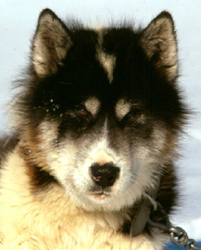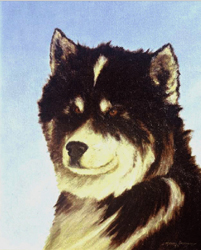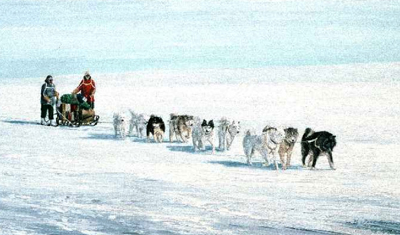In This Issue....
From the Editor:
Unfinished Business
FIDO: Leevan Etok
Fan MailIn the News
Happy Tenth Anniversary, ISDI
Sledge Dog Memorial Fund Update
Inuit Dog Research Project Underway
The Canadian Animal Assistance Team
The Chinook Project Goes to Cambridge Bay
Hints and Tips: Building a Dog Box, Pt. 1
Navigating This
Site
Index of articles by subject
Index
of back issues by volume number
Search The
Fan Hitch
Articles
to download and print
Ordering
Ken MacRury's Thesis
Our
comprehensive list of resources
Talk
to The
Fan Hitch
The Fan
Hitch home page
ISDI
home page
Editor's/Publisher's Statement
Editor: Sue Hamilton
Webmaster: Mark Hamilton
The
Fan Hitch, Journal of the Inuit Sled
Dog, is published four times a year. It is
available at no cost online at:
https://thefanhitch.org.
The Fan Hitch welcomes your letters, stories, comments and suggestions. The editorial staff reserves the right to edit submissions used for publication.
Contents of The Fan Hitch are protected by international copyright laws. No photo, drawing or text may be reproduced in any form without written consent. Webmasters please note: written consent is necessary before linking this site to yours! Please forward requests to Sue Hamilton, 55 Town Line Rd., Harwinton, Connecticut 06791, USA or mail@thefanhitch.org.
This site is dedicated to the Inuit Dog as well as related Inuit culture and traditions. It is also home to The Fan Hitch, Journal of the Inuit Sled Dog.
The Fan Hitch welcomes your letters, stories, comments and suggestions. The editorial staff reserves the right to edit submissions used for publication.
Contents of The Fan Hitch are protected by international copyright laws. No photo, drawing or text may be reproduced in any form without written consent. Webmasters please note: written consent is necessary before linking this site to yours! Please forward requests to Sue Hamilton, 55 Town Line Rd., Harwinton, Connecticut 06791, USA or mail@thefanhitch.org.
This site is dedicated to the Inuit Dog as well as related Inuit culture and traditions. It is also home to The Fan Hitch, Journal of the Inuit Sled Dog.
 |
 |
Remembering Changi
by Michael Skidmore
In advance of the eBay auction of my oil painting of Changi in December, 2007 on eBay in aid of the British Antarctic Sledge Dog Memorial Fund, I have written a short account of my sledging days with him and the Hairybreeks and Hobbits dog teams, all Greenland huskies. A detailed biography will be provided at the time of the auction.
I spent two years from January, 1967 to January, 1969 at Halley Bay, an isolated British Antarctic Survey (BAS) scientific base at approximately 76°S, 26°W. The base at Halley was and still is situated some three miles (4.8 km) from the ice cliffs at the edge of the Brunt Ice Shelf, on the eastern coast of the Weddell Sea, Antarctica. In those days we could only get there by ship, and to do any summer field work away from the base required a two-year stay. As a geologist I had been assigned to work in the Shackleton Range, some 340 miles (547 km) south, which had been discovered only some ten years before by the successful Trans-Antarctic Expedition, 1957-58, led by Sir Vivian Fuchs.
Thus my first season of sledging with Changi was during the austral summer of 1967-68. We undertook a sledge journey using Nansen sledges to prove the final part of a route to the Shackleton Range across an unexplored section of the high and featureless plateau of the Antarctic ice cap. The route had to be feasible for tractors to ferry supplies to the mountains in subsequent seasons.
From my painting Plateau Travel, I can introduce you to the Hairybreeks, Changi's dog team this season. They were led by Whisky, a quiet, dusky dark-gray and hard working dog. During his eight years he had learned to keep himself to himself at the end of the lead trace, and was wise enough to avoid contact with the other younger, more boisterous dogs following him.
 |
Plateau Travel
My oil painting of the Hairybreeks dog team travelling across the Antarctic ice cap
My oil painting of the Hairybreeks dog team travelling across the Antarctic ice cap
Chalky and Shem ran as front pair. Chalky was the only bitch in the team. She was white with dark gray markings, hard working and occasionally flirtatious. Along side her ran Shem, son of Whisky. He had a brindled coat and was as small as his brother Ham was large. Ham was running with the Mobsters, the other team were we sledged with. There was once a third brother, Japhet, to complete Noah's sons and biblical triplet but he was killed as a pup by another dog on base. Shem was a keen, willing and intelligent worker who became a fine leader the following year.
Next were brothers Wensen and Esk, a domineering pair. They were named after English rivers. Both were creamy white with dark markings, big, powerful and hard working. Esk was the more aggressive of the pair and fancied himself as 'king dog', but each day this was a matter of contention with his brother Wensen (with the dark ears). I regarded him as Esk's henchman and sidekick.
This season, brothers Changi and Luqa ran as third pair. They were big strong dogs and keen workers, but were dominated by the older pair of Wensen and Esk. Changi's coat was very dark reddish-brown with light-tan colored under parts and legs while his brother Luqa had a light brindled coat. They were from a remarkable litter of six male pups born at Halley Bay in 1966. Their brothers were Fedu, Sharjah, Tengah and Seletar; and they were all named after Middle and Far East RAF bases at the time.
Stroma and Skye were the rear pair. Their brothers Barra and Staffa were with the Mobsters, and all were named after Scottish Islands. Stroma and Skye had creamy white coats, were steady dogs of many seasons sledging, were unexcitable and avoided conflict of which their scarred noses, torn and crumpled ears were unwanted souvenirs. They also knew how to swing the lead, i.e. keep their traces taught without doing any serious work. Being six years-old they were now not built for speed, but came in handy for any 'low gear' or uphill work.
I got to know each dog best at the periodic rest stops when we would check them and untangle their traces. As the generally sunny and calm days of high summer passed, the different character of each dog became more apparent. This was when Changi made a lasting impression on me. His demands for notice were more restrained than the others and he just liked to be the focus of my personal attention for a few moments, enjoying the somewhat calmer social contact. In this way I found him more appealing than the others. On the other hand, I had to pass him to get to the front of the team!
The final members of the sledging team were Peter Noble and myself. Pete, in the red anorak, was in charge of the dogs, the sledge, the field equipment, and navigation, and became an outdoor training instructor in later life. My job was to study the geomorphology and geology of the Shackleton Range. In the event, we never got there overland. We discovered a large glacier across our route, and in circumnavigating the chaotic ice fields, heavy crevassing and ice falls, we ran out of both time and supplies and thus had to begin the long haul back to base for the winter.
My second field season began in November, 1968. Three dog teams were flown into the Shackleton Range for two months in a Hercules C-130 of the U.S. Navy VX6 Squadron assigned to support of the U.S. Antarctic Research Program. Pete Clarkson, the new geologist, and I sledged with the Hobbits, a newly formed team. This was the geological sledge and we adopted the radio call sign "Sledge Rox". A survey party of four others drove the Mobsters and the Beatles dog teams. Incidentally, the reading of Tolkein's works of The Hobbit and Lord of the Rings was all the rage on base at that time. Besides naming a dog team we also named several pups after his characters! Changi and Luqa were placed together in the Hobbits which was now led by their mother, Frosty. In general, the Hobbits running order was Frosty, white with dark gray markings, with Changi and Luqa now as first pair. Running as second pair was a small white bitch called Teifi, named after a Welsh river and a sibling of Wensen and Esk. Hitched alongside her was an older ginger-colored dog, Royal, who soon discovered we did not tolerate laziness. Snooty Esk and his arrogant brother Wensen ran as third pair. At the rear were two young, big, strong black and white brothers, Lister and Lobo, in their first season. On one trip we ran another dog in Royal's place called Mitral, a brindled cur, (the only dog ever to bite me), but as he made a habit of tormenting young Lister he was returned to his original team.
It's difficult to single out Changi during these journeys for any particular doggie story. I do remember however he once took a fancy to a small sample of pale-colored granite which I was carrying back in my hand from a nearby outcrop. As I passed the picketed dogs he had the idea, I suppose, that the granite in my hand bore a resemblance to a wrapped block of Nutrican, our compressed dog food. He pawed me and made a lunge for the rock. Fortunately, he bit gently at my gloved hand which must have softened the sudden shock when teeth met solid rock, both unyielding and unpalatable! From then on he used to shy away from any rock and scree debris we happened to pass close by. I realised then that for the whole of his young life he had never stood on any solid ground, having been born onto the snowy surface of the ice shelf at base. No wonder we had to clip the dogs' claws so frequently!
Toward the end of January, 1969, we were airlifted back to Halley Bay in time for the annual re-supply by ship. I had been in Antarctica for two years and now it was time to return home. Besides saying farewell to my colleagues remaining on base, there had to be time to say my goodbyes to another lot of old friends, my fellow travelers, sledgers and members of the Hairybreeks and Hobbits dog teams. That was a sad chore as I knew I would never see them again. I went round them one by one and bid them all a fond farewell, receiving slobbery and now blubbery kisses in turn for they were enjoying fresh seal meat on base once more. I like to think they were saying goodbye too and I recall particularly spending time with Changi, that reliable, intelligent, even-tempered, affectionate hunk of a husky with whom I had sledged so many miles. I have fond memories of them all.
As a postscript – Over the following seasons, Changi proved to be a little more gifted than the other huskies and he became a lead dog. For the huskies of BAS, we used the Inuit commands. There were only four a leader should obey and two for those running behind. All the dogs knew the command for stop – Ahhhhhh-now; most knew the command for go – Huit-away. But a leader had to know their left from their right and not all dogs could cope with that concept. Changi could, and in succeeding seasons he proved a wonderful leader. (The commands for left and right were Irrra-Irrra and Auk-Auk respectively) Sadly, Changi and all his team were lost in a crevasse incident in 1972, whilst crossing through the severe disturbance of the hinge zone some 30 miles (48 km) south of Halley Bay where the ice cap descends to sea level and floats off to sea forming the Brunt Ice Shelf.
Bibliography:
Fuchs, Sir Vivian, 1982. Of Ice and Men. The Story of the British Antarctic Survey, 1943-73. Anthony Nelson, England. 383 pp. ISBN 0 904614 06 9
Walton, K. and Rick Atkinson, 1996. Of Dogs and Men. Fifty years in the Antarctic. The Illustrated Story of the Dogs of the British Antarctic Survey, 1944 – 1994. Images Publishing (Malvern) Ltd, England. 190 pp. ISBN 1 897817 55 X